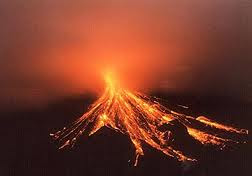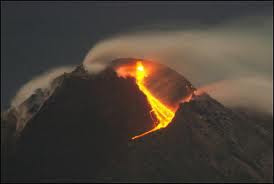Lava from Mount Merapi in Central Java, Indonesia began flowing down the Gendol River on 23 October, signalling the likelihood of an imminent eruption.
Volcanic Eruptions
In late October 2010 the Center for Volcanology and Geological Hazard Mitigation, Geological Agency (CVGHM), (Indonesian language—Pusat Vulkanologi & Mitigasi Bencana Geologi, Badan Geologi-PVMBG), reported that a pattern of increasing seismicity from Merapi had begun to emerge in early September. Observers at Babadan 7 kilometres (4.3 mi) west and Kaliurang 8 kilometres (5.0 mi) south of the mountain reported hearing an avalanche on 12 September 2010. On 13 September 2010 white plumes were observed rising 800 metres (2,600 ft) above the crater. Lava dome inflation, detected since March, increased from background levels of 0.1 millimetres (0.0039 in) to 0.3 millimetres (0.012 in) per day to a rate of 11 millimetres (0.43 in) per day on 16 September. On 19 September 2010 earthquakes continued to be numerous, and the next day CVGHM raised the Alert Level to 2 (on a scale of 1–4). Lava from Mount Merapi began flowing down the Gendol River on 23–24 October signalling the likelihood of an imminent eruption.
On 25 October 2010 the Indonesian government raised the alert for Mount Merapi to its highest level (4) and warned villagers in threatened areas to move to safer ground. People living within a 10 kilometres (6.2 mi) zone were told to evacuate. The evacuation orders effected at least 19,000 people however the number that complied at the time remained unclear to authorities. Officials said about 500 volcanic earthquakes had been recorded on the mountain over the weekend of 23–24 October, and that the magma had risen to about a 1 kilometre (3,300 ft) below the surface due to the seismic activity Merapi erupted three times on Monday afternoon 25 October 2010, spewing lava down its southern and southeastern slopes. Three major eruptions were recorded at 2:04PM, 2:24PM and 3:15PM. On 25 October 222 volcanic seismic events and 454 avalanche seismic events were recorded by Center for Volcanology and Geological Hazard Mitigation monitoring staff at Merapi.
 |
| Eruption of Mount Merapi 2010, |
The eruptions on 26 October started at 5:02PM. By 6:54PM pyroclastic activity had begun to subside following 12 eruption associated events being recorded by CVGHM monitors. In the 24 hours of 26 October 232 volcanic seismic events, 269 avalanche seismic events, 4 lava flow seismic events and 6 heat clouds were recorded by Center for Volcanology and Geological Hazard Mitigation monitoring staff at Merapi. The eruptive events of 26 October were classified as an explosive event with volcanic bursts of ejected material, visable flame and pyroclastic hot air flows. A column of smoke rose from the top to a vertical distance of 1.5 kilometres (0.93 mi) from the summit of the Mount Merapi.
On Friday 29 October activity including lava ejection and hot ash clouds increased and by early on the morning of Saturday 30 October explosive eruptions were occurring again. The eruptions were reported to be louder and stronger than the eruptions that killed 34 people on the previous Tuesday with ash falling more than 12 kilometres (7.5 mi) away.
Casualties
On 26 October at least 18 people, including one 2-month old baby, were found dead due to burns and respiratory failure caused by hot ashes from the eruption.Thousands were evacuated within a radius of 10 kilometres (6.2 mi) around the slopes of the volcano.
By Wednesday 27 October the death toll had risen to at least 25. The death toll included an elder, Mbah Maridjan (grandfather Marijan), known as the volcano's spiritual gatekeeper who was found dead at his home approximately 4 kilometres (2.5 mi) from the peak. The Yogyakarta Palace subsequently confirmed his death. The 10 kilometres (6.2 mi) exclusion zone remained in place at the volcano with evacuation and ongoing search and rescue activities continuing at the site in an attempt to locate further victims of the previous days eruptions.
Later reports on the 27 October revised the toll upward to 30 persons recorded at Yogyakarta's Dr. Sardjito Hospital with 17 hospitalized, mostly with burns, respiratory problems and other injuries. Earlier on 27 October two of the 28 bodies at the hospital had been identified. Yuniawan Nugroho, an editor with the vivanews.com news portal, was reported to have been killed while conducting reportage on the night of Tuesday 26 October, the other belonging to a yet un-named Indonesian Red Cross worker.
Lava Dome deformation
During the 4th week of October 2010 deformation measurements were performed by Electric Distance Measurement (EDM), utilising reflectors mounted around the summit of Mount Merapi. The measurement results Indicated a rapidly increasing rate of growth of the lava dome in the build up to the eruptive events of 25–26 October 2010.
At the end of September 2010, the peak inflation rate of the lava dome at Mount Merapi was measured by EDM at an average growth rate of 6 millimetres (0.24 in). The subsequent rate of inflation up until October 21, 2010 reached 105 millimetres (4.1 in) per day. The inflation rate then increased very sharply, reaching 420 millimetres (17 in) per day by 24 October 2010. By the 25 October the average grow rate, measured from 6 EDM points over 24-25 October had risen to 500 millimetres (20 in) per day, the top of dome having by then reached a height of 6,858.635 metres (22,502.08 ft) above sea level.
The information gathered at the site indicated that the distension of the mountain’s slopes was much more rapid this during the current event than that observed during the 2006 event.
On 26 October the head of the Indonesian Center for Volcanology and Geological Hazard Mitigation, Surono, repeated his earlier statements that the greatest concern was the pressure building behind a massive lava dome that has formed near the tip of the crater. "The energy is building up. ... We hope it will release slowly," he said. "Otherwise we're looking at a potentially huge eruption, bigger than anything we've seen in years". Surono also said that said the distension of the mountain’s slopes was much more rapid this time around, indicating a higher-pressure build-up of gas and hence a much more explosive eruption and speculated that Merapi may erupt explosively, as it did in 1930, and not just eject gas as in 2006 eruptions.


No comments:
Post a Comment